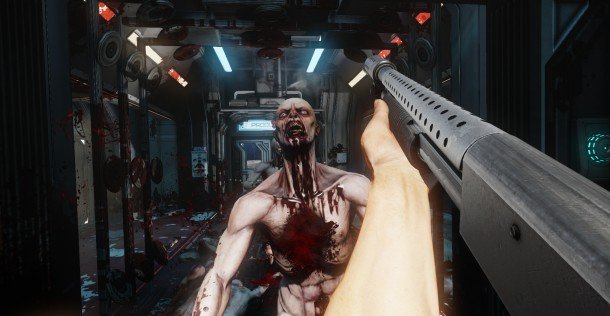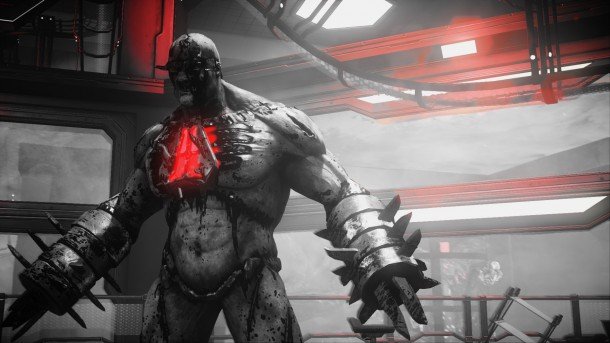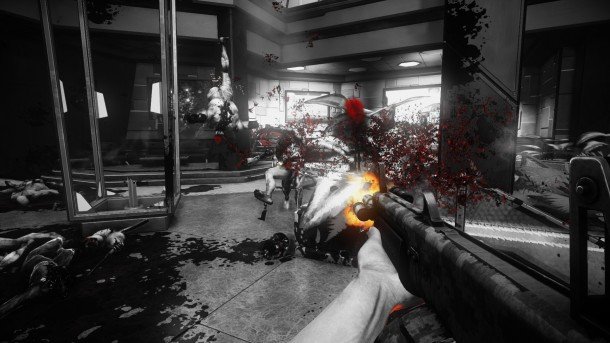Killing Floor 2's gore system is a bloody ballet

Wes gave Killing Floor 2's gore tech a thorough dissection earlier this year when we revealed Tripwire's cooperative, wave-based horror FPS with his huge feature story. In short, Killing Floor 2's “ MEAT ” system (Massive Evisceration and Trauma) is ridiculous—enemies have 19 points of dismemberment (five alone for the head), and it makes Killing Floor 2 feel more like flesh bowling than a standard shooter.
To Tripwire, this gore system is the most important feature of Killing Floor 2. I had a chance to see it in bloody action in an updated build earlier this week, and what impressed me most wasn't the amount of blood and violence but the creative FPS gameplay the system seems to stimulate.
Tripwire hasn't released any gameplay footage of KF2 quite yet, so you'll have to rely on my words to describe the moment-to-moment carnage I witnessed. I saw a few waves of KF2 played live, through which it was apparent that the basic rhythm of KF isn't fundamentally changing: you backpedal, you kite ugly enemies, and you thin the hordes of genetic freaks as efficiently as you can. What was new was the way that KF2's fidelity stimulated new moments and decisions.
Grenades, for example, now release a few chunks of shrapnel that ricochet, and these fragments can bite into KF2's new dynamic lights and breakable objects. A thrown grenade is still an effective band-aid for the horde of Clots coming your way, but the explosion might also kill the only light sources in a hallway or a basement. I like the idea of having to make that snap cost-benefit analysis about how a single frag grenade could make a piece of the level more dangerous by darkening it; it's something that didn't exist on the ancient Unreal tech of Killing Floor the first.
There's more subtlety to the animation and physics in general, too: every enemy ragdolls and drops dead in a way that's symmetrical to your weapon and the direction you're firing from, and this fidelity allows for set-up moves like tossing a grenade well behind a pack of enemies, then mowing them down as the ones nearest to you stumble forward from the blast. Corpses also persist in the environment for a good amount of time, and they can be shot to pieces when dead; something that wasn't the case in Left 4 Dead 2. More importantly, KF2 allows for what Tripwire has nicknamed “Zed juggling”: in slow motion, a cartwheeling enemy can be propelled upward with successive shots, or dissected in mid-air. I expect I'll naturally want to do this: even KF2's basic enemies are articulate, blood-filled piñatas that absorb buckshot and rifle rounds with gross-yet-gorgeous authenticity.

Most significant, though, are the changes made to melee. Tripwire only had a katana to show (and mentioned a sledgehammer), but rather than the sword operating as a one-dimensional weapon, there's a surprising amount of nuance. Left mouse is light attack, and right mouse is heavy, but more importantly the direction you're moving at the time you attack on WASD dictates the motion of your attack. The katana's heavy, horizontal slash is one of the most impressive real-time animations I've seen in a game: I watched the sword effortlessly tear the entire upper body off a Clot, sending it across the room while the legs stood frozen in place. You can also hold block (to reduce, but not fully eliminate melee damage) or try to time a block perfectly against an oncoming melee attack to briefly stagger that enemy. Already I'm imagining a front-line melee player, who's mastered the technique, stopping a Fleshpound (which Tripwire said will be blockable) in its tracks so his teammates can get in some easy shots.
Another detail I liked: the knockback force varied noticeably between shotguns. Crouching and firing the double-barrel shotgun kicked a Clot skyward like a punted football, while the mag-fed AA-12 shotgun cut through enemies more cleanly with chunky, rapid fire. Outside of the gore system, Tripwire showed off a new aspect of the perks system: perk skills. Every five levels of perk progression, you have to pick one of two potential skills. For one Support tier, for example, you might pick between having 25% more carrying capacity or dealing 10% more damage with Support-specific weapons like shotguns. I'm glad to see Tripwire introducing some customization to character progression, considering how many 500-plus hour Killing Floor players there seem to be.
The biggest gaming news, reviews and hardware deals
Keep up to date with the most important stories and the best deals, as picked by the PC Gamer team.

If you've played Killing Floor, you know how inherently repetitive it is: waves of enemies magnetize to your position in the style of a horde-mode game, crawling, shambling, or stumbling at you in successively larger packs until they're dead or you are. Tripwire has still only shown a couple chunks of what I expect the final game to include, but almost everything we've seen is focused on diffusing the game's natural repetition with dynamic systems that will probably age quite slowly. Another exciting example of this are the behaviors of enemies themselves, which vary based on difficulty level. At higher difficulties, a basic Zed might gain a pounce attack, or somersault to avoid a headshot, or sprint when shot as a reaction maneuver. It's nice to see Tripwire taking a complex approach to designing its otherwise simple, straightforward horror FPS.

Evan's a hardcore FPS enthusiast who joined PC Gamer in 2008. After an era spent publishing reviews, news, and cover features, he now oversees editorial operations for PC Gamer worldwide, including setting policy, training, and editing stories written by the wider team. His most-played FPSes are CS:GO, Team Fortress 2, Team Fortress Classic, Rainbow Six Siege, and Arma 2. His first multiplayer FPS was Quake 2, played on serial LAN in his uncle's basement, the ideal conditions for instilling a lifelong fondness for fragging. Evan also leads production of the PC Gaming Show, the annual E3 showcase event dedicated to PC gaming.

